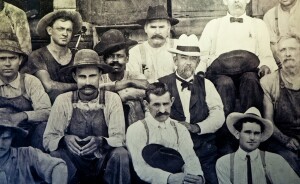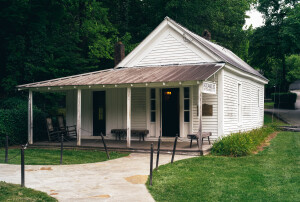
Photo of Jack Daniels with George Green (Nearest Green’s son) via: https://www.jackdaniels.com/en-us/vault
Within the world of spirits, students and connoisseurs alike quickly learn that the story and history of a spirit, the lore behind the bottle, can be as compelling as the actual beverage. Knowing about the people that spent their lives making the products we love allows us to feel connected to them and the entire tradition around those drinks. However, it is very often the case that we do not have the entire story. It takes the work of historians and writers to uncover the stories behind the stories. It took this kind of work to bring one remarkable man out of the shadows of history and into the light of the present day – Nathan “Nearest” Green or as he was known to his friends and family “Uncle Nearest.”
Nearest Green was born into slavery sometime in the early 1800s. The history of his early life is hard to piece together, but by the mid-1800s he was held by a company called Landis & Green which would hire out Green’s labor. Lutheran Minister Dan Call hired Nearest in the 1850s through this company. Call ran a farm, a successful general store, and a still in Lois, TN, just outside of Lynchburg. From all available accounts, Nearest acted as the head distiller for the operation, which was not an uncommon role for enslaved African Americans throughout America.
After working and running the still for Call for some time, a pre-teen Jack Daniels arrived at the operation intent on learning how to make whiskey. Call referred to Nearest as the “best whiskey maker” he knew, making him an ideal mentor for the young Daniels. The two spent years working side by side, making whiskey throughout the entire course of the Civil War. Nearest’s enslavement formally ended with the passage of the 13th Amendment, and after which he chose to continue working with Daniels and Call. By the late 1860s the whiskey business was thriving and after Call had a crisis of conscience he sold his stake to Daniels which resulted in the creation of the Jack Daniel Distillery. Nearest became its first head distiller, the equivalent to a modern-day master distiller.
Nearest worked alongside Jack Daniels for many years, up until his retirement in the 1880s. His career and success made him one of the wealthiest men in Lynchburg and his dedication to distillation became a family tradition. His sons, George and Eli, went to work for Daniels, as well as several of his grandchildren. Ultimately, over the past century and a half, seven generations of Green’s descendants have worked for the Jack Daniels distillery.
Nearest Green’s story was common knowledge to the families of Lynchburg. Past historians also knew of his contributions to Tennessee and American whiskey. Yet it was not until a few years ago that the man and legend of Nearest Green entered the mainstream public consciousness – primarily through the work of author Fawn Weaver. Over the course of a year of research, Weaver assembled the facts and pieces of Nearest’s life, spending countless hours interviewing his descendants and the people of Lynchburg. Through oral history, historic records, and artifacts, we now have a more complete look at the early days of Jack Daniels and the indispensable impact Nearest had upon it.
The legacy of Nearest Green is preserved today in several ways. There’s a non-profit organization, the Nearest Green Foundation, dedicated to preserving and sharing the history of Nearest. There’s also a scholarship program, the Nearest Green Legacy Scholarship, dedicated to helping provide educational opportunities to descendants of Nearest. And, perhaps most famously, the Tennessee whiskey brand, Uncle Nearest, that bears his name in tribute to his achievements as an African American distiller in the nineteenth-century.
About the author: Ben Coffelt, CSS, CSW serves as a Sales Director for the Society of Wine Educators (SWE). Originally from California, Ben Coffelt started his wine and spirits career leading customer tastings and staff trainings at Trader Joe’s. His love of history drives his interests, and he’s always eager to learn about a new place, person, or product. He can often be found sipping rum with his French Bulldog, Hobbes.
References/for more information:
